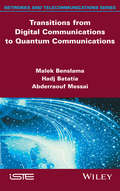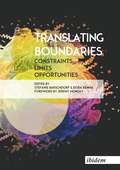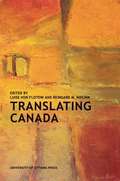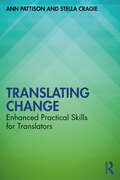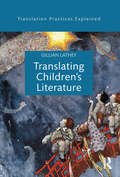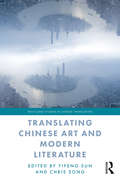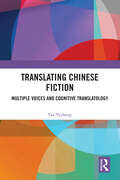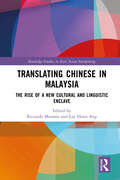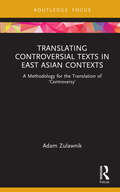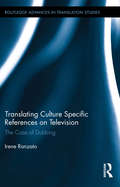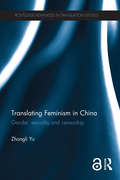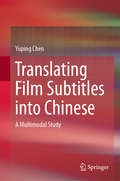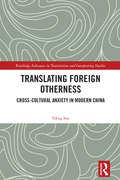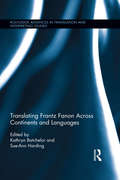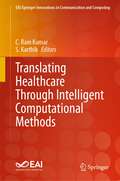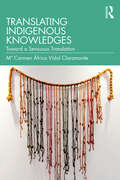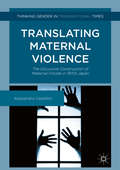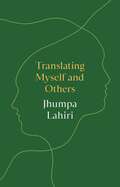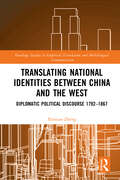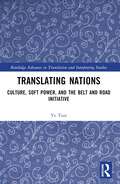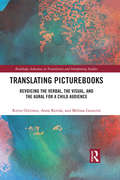- Table View
- List View
Transitioning to Virtual and Hybrid Events: How to Create, Adapt, and Market an Engaging Online Experience
by Ben ChodorCreating virtual events is not as simple as moving the same content online — learn how to immediately leverage virtual solutions for effective in-person online events As the global COVID-19 pandemic continues to have unprecedented impact on both the global economy and the whole of the world population, the need for effectively and efficiently connecting people and the right information has never been more urgent. Although the technology infrastructure currently exists, many organizations are scrambling to create virtual meetings and events to address important time-sensitive issues. Transitioning to Virtual and Hybrid Events explains everything an event host needs to know about going virtual, from understanding the new audience, to adapting content to the new medium, to marketing effectively, and much more. Author Ben Chodor, president of Intrado Digital Media, provides expert advice and real-world instructions for delivering engaging hybrid, virtual, and streaming events and webinars for companies of all sizes and across all industries. Packed with detailed tutorials, real-world case studies, illustrative examples, and highly useful checklists, this comprehensive resource provides step-by-step guidance on: Planning, creating, and implementing a digital event Choosing between a stream, a webcast, or a hybrid event Evaluating different technological solutions Producing compelling virtual content for a variety of scenarios Effectively promoting online events Meeting the needs of a diverse and global audience Transitioning to Virtual and Hybrid Events is an indispensable instruction manual for anyone tasked with enhancing their organization’s continuity plans, enabling their employee base to work remotely, or creating any type of virtual solution to meet this urgent crisis.
Transitions from Digital Communications to Quantum Communications: Concepts and Prospects
by Malek Benslama Hadj Batatia Abderraouf MessaiThis book addresses the move towards quantum communications, in light of the recent technological developments on photonic crystals and their potential applications in systems. The authors present the state of the art on extensive quantum communications, the first part of the book being dedicated to the relevant theory; quantum gates such as Deutsch gates, Toffoli gates and Dedekind gates are reviewed with regards to their feasibility as electronic circuits and their implementation in systems, and a comparison is performed in parallel with conventional circuits such as FPGAs and DSPs. The specifics of quantum communication are also revealed through the entanglement and Bell states, and mathematical and physical aspects of quantum optical fibers and photonic crystals are considered in order to optimize the quantum transmissions. These concepts are linked with relevant, practical examples in the second part of the book, which presents six integrated applications for quantum communications.
Translating Boundaries: Constraints, Limits, Opportunities
by Stefanie Barschdorf Dora RennaTranslation studies have traditionally been known to be interdisciplinary. What better term to sum this up than boundaries? A term that means different things in different fields and can be applied to a multitude of topics. Political, personal, symbolic, or professional boundaries, boundaries of the mind as found in psychology, or boundaries in the sociological sense where they separate different fields of knowledge. From politics to geography, boundaries are everywhere. They need to be identified, drawn, or overcome—depending on circumstances and context. What are the boundaries translators and interpreters have to deal with? How do they relate to translation studies in general? Boundaries and translation go hand in hand. As the discipline grows and ever more elements of interdisciplinarity come into play, the more the question of what the boundaries of translation are needs to be asked. Some of the research topics presented in this collection may well extend the boundaries of the discipline itself, while others may look at the constraints and limits under which translators and translations operate, or showcase the role translation and interpreting play in overcoming social or political boundaries.It is with this in mind that the group of young researchers presented in this book has come together. The papers offer insights into the state of the discipline in various nations, often touching on underresearched topics such as the role of translation in the creation of national as well as individual identities or the translation of popular music. They look at the role of culture and, more specifically, sociocultural influences on translation. At the same time, non-linguistic, intra- and extratextual factors are taken into account with particular attention to multimodality. What unites the papers collected is the general tendency to see translation as a means of bringing people together and enabling dialogue, a means of overcoming ideological and social boundaries. By looking both to the past and the future of the discipline, the authors aim to (re)define the boundaries of translation studies.
Translating Canada (Perspectives on Translation)
by Luise Von Flotow Reingard M. NischikIn the last thirty years of the twentieth century, Canadian federal governments offered varying degrees of support for literary and other artistic endeavour. A corollary of this patronage of culture at home was an effort to make the resulting works available for audiences elsewhere in the world. Current developments in the study of translation and its influence as cultural transfer have made possible new assessments of such efforts to project a national image abroad. Translating Canada examines cultural materials exported by Canada in addition to those selected for acquisition by German publishers, theatres, and other culture brokers. It also considers the motivations of particular translators and the reception by German reviewers of works by a wide variety of Canadian writers -- novelists and poets, playwrights and children's authors, literary and social critics. Above all, the book maps for its readers a number of significant, though frequently unsuspected, roles that translation assumes in the intercultural negotiation of national images and values. The chapters in this collection will be of value to students, teachers, and scholars in a number of fields. Informed lay readers, too, will appreciate the authors’ insights into the different ways in which translation has contributed to German reception of Canadian books and culture.
Translating Change: Enhanced Practical Skills for Translators
by Stella Cragie Ann PattisonTranslating Change explores and analyses the impact of changes in society, culture and language on the translation and interpreting process and product. It looks at how social attitudes, behaviours and values change over time, how languages respond to these changes, how these changes are reflected in the processing and production of translations and how technological change and economic uncertainty in the wake of events such as the COVID-19 pandemic and Brexit affect the translation market. The authors examine trends in language change in English, French, German, Italian and Spanish. The highly topical approach to social, cultural and language change is predominantly synchronic and pragmatic, based on tracking and analysing language changes and trends as they have developed and continue to do so. This is combined with an innovative section on developing transferable translation-related skills, including writing and rewriting, editing, abstracting, transcreation and summary writing in view of a perceived need to expand the skills portfolio of translators in a changing market and at the same time to maximise translation quality. Each chapter features Pause for Thought/activity boxes to encourage active reader participation or reflection. With exercises, discussion questions, guided further reading throughout and a glossary of key terms, this innovative textbook is key reading for both students and translators or interpreters, in training and in practice.
Translating Children's Literature (Translation Practices Explained)
by Gillian LatheyTranslating Children’s Literature is an exploration of the many developmental and linguistic issues related to writing and translating for children, an audience that spans a period of enormous intellectual progress and affective change from birth to adolescence. Lathey looks at a broad range of children’s literature, from prose fiction to poetry and picture books. Each of the seven chapters addresses a different aspect of translation for children, covering: · Narrative style and the challenges of translating the child’s voice; · The translation of cultural markers for young readers; · Translation of the modern picture book; · Dialogue, dialect and street language in modern children’s literature; · Read-aloud qualities, wordplay, onomatopoeia and the translation of children’s poetry; · Retranslation, retelling and reworking; · The role of translation for children within the global publishing and translation industries. This is the first practical guide to address all aspects of translating children’s literature, featuring extracts from commentaries and interviews with published translators of children’s literature, as well as examples and case studies across a range of languages and texts. Each chapter includes a set of questions and exercises for students. Translating Children’s Literature is essential reading for professional translators, researchers and students on courses in translation studies or children’s literature.
Translating Chinese Art and Modern Literature (Routledge Studies in Chinese Translation)
by Yifeng Sun Chris SongTranslating Chinese Art and Modern Literature examines issues in cross-cultural dialogue in connection with translation and modern Chinese art and literature from interdisciplinary perspectives. This comprises the text-image dialogue in the context of Chinese modernity, and cross-cultural interaction between modern literature in Chinese and other literatures. This edited collection approaches these issues with discrete foci and approaches, and the ten chapters in this volume are to be divided into two distinct parts. The first part highlights the mutual effects between literary texts and visual images in the media of book, painting, and film, and the second part includes contributions by scholars of literary translation.
Translating Chinese Fiction: Multiple Voices and Cognitive Translatology
by Tan YeshengDrawing on the cognitive translatological paradigm, this book introduces a situation-embedded cognitive construction model of translation and explores the thinking portfolios of British and American sinologists-cum-translators to re-examine their multiple voices and cognition in translating Chinese fiction.By placing sinologists-cum-translators in the same discourse space, the study transcends the limitations of previous case studies and offers a comprehensive cognitive panorama of how Chinese novels are rendered. The author explores the challenges and difficulties of translating Chinese fiction from the insider perspectives of British and American sinologists, and cross-validates their multiple voices by aligning them with cross-cultural communication scenarios. Based on the cognitive construction model of translation, the book provides a systematic review of the translation thoughts and ideas of the community of sinologists in terms of linguistic conventions, narrative styles, contextual and cultural frames, readership categories and metaphorical models of translation. It envisions a new research path to enhance empirical research on translators' cognition in a dynamic translation ecosystem. The title will be an essential read for students and scholars of translation studies and Chinese studies. It will also appeal to translators and researchers interested in cognitive stylistics, literary studies and intercultural communication studies.
Translating Chinese in Malaysia: The Rise of a New Cultural and Linguistic Enclave (Routledge Studies in East Asian Interpreting)
by Riccardo Moratto Lay Hoon AngShedding light on the nuances of cross-cultural communication, this edited volume offers insights into how Chinese Malaysians, a major ethnic group, navigate the complexities of translating across diverse languages.This book unveils the unique landscape of translation from Chinese in Malaysia, where the emphasis lies not just in theoretical nuances but in the practical application of bridging linguistic divides. The narrative unfolds the dedicated efforts of the local Chinese community, passionately engaged in translating literary gems and unraveling language intricacies. It provides a platform to explore how Chinese Malaysians use translation as a tool to maintain and transmit their linguistic and cultural legacy. By highlighting specific works and creative endeavours, the authors showcase the unique contributions of the Chinese community to the broader field of translation, fostering an appreciation for the cultural and artistic dimensions embedded in the translated texts.This book serves as an educational tool for students, scholars, and researchers interested in translation studies and multiculturalism. It also provides a comprehensive exploration of the challenges and opportunities faced by Chinese translators in Malaysia, encouraging further research and fostering a deeper understanding of the field.
Translating Controversial Texts in East Asian Contexts: A Methodology for the Translation of ‘Controversy’ (Routledge Advances in Translation and Interpreting Studies)
by Adam ZulawnikZulawnik focuses on the broad concept of ‘controversy’ and issues pertaining to the translation of politically and historically controversial texts in East Asia. The research methodology is exemplified through a case study in the form of the author’s translation of the best-selling Japanese graphic novel (manga) Manga Kenkanryū (Hate Hallyu: The Comic) by Sharin Yamano (2005), a work that has been problematised as an attack on South Korean culture and the Korean Wave. Issues analysed and discussed in the research include translation risk, ethics, a detailed methodology for the translation of so-called controversial texts exemplified through numerous thematically divided examples from the translation of the chosen Japanese text, as well as examples from a Korean language equivalent (Manhwa Hyeomillyu – Hate Japanese Wave), and definition and contextualisation of the concept of ‘controversy’. There has been limited research in the field of translation studies, which seeks to exemplify potential pragmatic approaches for the translation of politically-charged texts, particularly in multi-modal texts such as the graphic novel. It is hoped that Zulawnik’s research will serve both as a valuable source when examining South Korea–Japan relations and a theoretical and methodological base for further research and the development of an online augmented translation space with devices specifically suited for the translation of multi-modal texts such as – but not limited to – graphic novels and visual encyclopaedias.
Translating Culture Specific References on Television: The Case of Dubbing (Routledge Advances in Translation and Interpreting Studies)
by Irene RanzatoTranslating Culture Specific References on Television provides a model for investigating the problems posed by culture specific references in translation, drawing on case studies that explore the translational norms of contemporary Italian dubbing practices. This monograph makes a distinctive contribution to the study of audiovisual translation and culture specific references in its focus on dubbing as opposed to subtitling, and on contemporary television series, rather than cinema. Irene Ranzato’s research involves detailed analysis of three TV series dubbed into Italian, drawing on a corpus of 95 hours that includes nearly 3,000 CSR translations. Ranzato proposes a new taxonomy of strategies for the translation of CSRs and explores the sociocultural, pragmatic and ideological implications of audiovisual translation for the small screen.
Translating Feminism in China: Gender, Sexuality and Censorship (Routledge Advances in Translation and Interpreting Studies)
by Zhongli YuThis book explores translation of feminism in China through examining several Chinese translations of two typical feminist works: The Second Sex (TSS, Beauvoir 1949/1952) and The Vagina Monologues (TVM, Ensler 1998). TSS exposes the cultural construction of woman while TVM reveals the pervasiveness of sexual oppression toward women. The female body and female sexuality (including lesbian sexuality) constitute a challenge to the Chinese translators due to cultural differences and sexuality still being a sensitive topic in China. This book investigates from gender and feminist perspectives, how TSS and TVM have been translated and received in China, with special attention to how the translators meet the challenges. Since translation is the gateway to the reception of feminism, an examination of the translations should reveal the response to feminism of the translator as the first reader and gatekeeper, and how feminism is translated both ideologically and technically in China. The translators’ decisions are discussed within the social, historical, and political contexts. Translating Feminism in China discusses, among other issues: Feminist Translation: Practice, Theory, and Studies Translating the Female Body and Sexuality Translating Lesbianism Censorship, Sexuality, and Translation This book will be relevant to postgraduate students and researchers of translation studies. It will also interest academics interested in feminism, gender studies and Chinese literature and culture. Zhongli Yu is Assistant Professor of Translation Studies at the University of Nottingham Ningbo China (UNNC).
Translating Film Subtitles into Chinese: A Multimodal Study
by Yuping ChenThis book examines three metafunction meanings in subtitle translation with three research foci, i.e., the main types of cross-modal interrelation, the primary function of semiotic interplay, and the key linguistic components influencing the subtitles. It goes beyond traditional textual analysis in translation studies; approaches subtitle translation from a multimodality standpoint; and breaks through the linguistic restraints on subtitling research by underscoring the role of semiotic interplay. In the field of multimodality, this book bridges subtitling and multimodality by investigating the interweaving relationships between different semiotic modes, and their corresponding impacts on subtitle translation.
Translating Foreign Otherness: Cross-Cultural Anxiety in Modern China (Routledge Advances in Translation and Interpreting Studies)
by Yifeng SunThis book explores the deep-rooted anxiety about foreign otherness manifest through translation in modern China in its endeavours to engage in cross-cultural exchanges. It offers to theorize and contextualize a related range of issues concerning translation practice in response to foreign otherness. The book also introduces new vistas to some of the under-explored aspects of translation practice concerning ideology and cultural politics from the late Qing dynasty to the present day. Largely as a result of translation, ethnocentric beliefs and feelings have given way to a more open and liberal way to approach and appropriate foreign otherness. However, the fear of Westernization, seen as a threat to Chinese cultural integrity and social stability, is still shown sporadically through the state’s ideological control over translation. The book interprets, questions and reformulates a number of the key theoretical issues in Translation Studies and also demonstrates their ramifications in a bid to shed light on Chinese translation practice.
Translating Frantz Fanon Across Continents and Languages: Frantz Fanon Across Continents and Languages (Routledge Advances in Translation and Interpreting Studies)
by Sue-Ann Harding Kathryn BatchelorThis book provides an innovative look at the reception of Frantz Fanon’s texts, investigating how, when, where and why these—especially his seminal Les Damnés de la Terre (1961) —were first translated and read. Building on renewed interest in the author’s works in both postcolonial studies and revolutionary movements in recent years, as well as travelling theory, micro-history and histoire croisée interests in Translation Studies, the volume tells the stories of translations of Fanon’s texts into twelve different languages – Arabic, Danish, English, German, Italian, Norwegian, Persian, Polish, Russian, Serbo-Croatian, Swahili and Swedish – bringing both a historical and multilingual perspective to the ways in which Fanon is cited today. With contributions from an international, interdisciplinary group of scholars, the stories told combine themes of movement and place, personal networks and agency, politics and activism, archival research and textual analysis, creating a book that is a fresh and comprehensive volume on the translated works of Frantz Fanon and essential reading for scholars in translation studies, postcolonial studies, cultural studies, critical race studies, and African and African diaspora literature.
Translating Great Russian Literature: The Penguin Russian Classics (BASEES/Routledge Series on Russian and East European Studies)
by Cathy McAteerLaunched in 1950, Penguin’s Russian Classics quickly progressed to include translations of many great works of Russian literature and the series came to be regarded by readers, both academic and general, as the de facto provider of classic Russian literature in English translation, the legacy of which reputation resonates right up to the present day. Through an analysis of the individuals involved, their agendas, and their socio-cultural context, this book, based on extensive original research, examines how Penguin’s decisions and practices when translating and publishing the series played a significant role in deciding how Russian literature would be produced and marketed in English translation. As such the book represents a major contribution to Translation Studies, to the study of Russian literature, to book history and to the history of publishing.
Translating Great Russian Literature: The Penguin Russian Classics (ISSN)
by Cathy McAteerLaunched in 1950, Penguin’s Russian Classics quickly progressed to include translations of many great works of Russian literature and the series came to be regarded by readers, both academic and general, as the de facto provider of classic Russian literature in English translation, the legacy of which reputation resonates right up to the present day. Through an analysis of the individuals involved, their agendas, and their socio-cultural context, this book, based on extensive original research, examines how Penguin’s decisions and practices when translating and publishing the series played a significant role in deciding how Russian literature would be produced and marketed in English translation. As such the book represents a major contribution to Translation Studies, to the study of Russian literature, to book history and to the history of publishing.
Translating Healthcare Through Intelligent Computational Methods (EAI/Springer Innovations in Communication and Computing)
by C. Ram Kumar S. KarthikThis book provides information on interdependencies of medicine and telecommunications engineering and how Covid exemplifies how the two must rely on each other to effectively function in this era. The book discusses new techniques for medical service improvisation such as clear cut views on medical technologies. The authors provide chapters on processing of medical amenities using medical images, the importance of data and information technology in medicine, and machine learning and artificial intelligence in healthcare. Authors include researchers, academics, and professionals in the field of communications engineering with a variety of perspectives.
Translating Indigenous Knowledges: Toward a Sensuous Translation
by Mª Carmen Vidal ClaramonteIn this book, Vidal presents a new way of translating indigenous epistemologies. For centuries, the Western world has ordained what knowledge is and what it should be and has also been responsible for transmitting that knowledge. This "universal" knowledge has traveled to the four corners of the globe.In recent decades, there has been a steadily growing interest in dialogical epistemologies. Disciplines ranging from historiography and philosophy to anthropology are calling for this universalist idea of knowledge to be modified. Thanks to this change of perspective, other forms of knowledge, which until now have been ignored, are gradually coming to light. Indigenous knowledges are not constructed with the scientific, binary, static, Cartesian, or univocal logic characteristic of Western societies. Non-Western types of knowledge incorporate senses, emotions, body, objects, and matter. It is impossible to reduce indigenous knowledges to Western conceptualizations. The types of translation covered in this book assume that knowledge is not transmitted only in the Western way and that there are world views that take into account the emotions and body, as well as the intellect. This includes all types of beings: human, non-human, and extrahuman. In the face of this plurality of epistemologies, this book affirms that the static Western conceptual traditions characterized by a binary logic are not useful and that there is a need to translate outside the scope of these traditions.The examples given in this book show that translation is not only a process involving Western and non-Western languages. Translation is not a mere substitution of one word for another because knowledge is not only transmitted through words. It also involves non-verbal elements. Knowledge is transmitted through objects, songs, sensations, and emotions, as well as through words. Moreover, many non-Western traditions do not translate with language systems but rather with other semiotic systems, such as knots, threads, colors, and bodies in movement. This is a timely, topical, and transdisciplinary reading, of interest to advanced students and researchers in translation studies, anthropology, and beyond.
Translating Law
by Deborah CaoThe translation of law has played an integral part in the interaction among nations in history and is playing a greater role in our increasingly interconnected world today. The book investigates legal translation in its many facets as an intellectual pursuit and a profession. It examines legal translation from an interdisciplinary perspective, covering theoretical and practical grounds and linguistic as well as legal issues. It analyses legal translation competence and various types of legal texts including contracts, statutes and multilateral legal instruments, presents a comparative analysis of the Common Law and the Civil Law and examines the case law from Canada, Hong Kong and the European Court of Justice. It attempts to demonstrate that translating law is a complex act that can enrich law, culture and human experience as a whole.
Translating Maternal Violence: The Discursive Construction of Maternal Filicide in 1970s Japan (Thinking Gender in Transnational Times)
by Alessandro CastelliniThis book provides the first full-length, English-language investigation of the multiple and often contradictory ways in which mothers who kill their children were portrayed in 1970s Japan. It offers a snapshot of a historical and social moment when motherhood was being renegotiated, and maternal violence was disrupting norms of acceptable maternal behaviour. Drawing on a wide range of original archival materials, it explores three discursive sites where the image of the murderous mother assumed a distinctive visibility: media coverage of cases of maternal filicide; the rhetoric of a newly emerging women’s liberation movement known as ūman ribu; and fictional works by the Japanese writer Takahashi Takako. Using translation as a theoretical tool to decentre the West as the origin of (feminist) theorizations of the maternal, it enables a transnational dialogue for imagining mothers' potential for violence. This thought-provoking work will appeal to scholars of feminist theory, cultural studies and Japanese studies.
Translating Myself and Others
by Jhumpa LahiriLuminous essays on translation and self-translation by the award-winning writer and literary translatorTranslating Myself and Others is a collection of candid and disarmingly personal essays by Pulitzer Prize–winning author Jhumpa Lahiri, who reflects on her emerging identity as a translator as well as a writer in two languages.With subtlety and emotional immediacy, Lahiri draws on Ovid’s myth of Echo and Narcissus to explore the distinction between writing and translating, and provides a close reading of passages from Aristotle’s Poetics to talk more broadly about writing, desire, and freedom. She traces the theme of translation in Antonio Gramsci’s Prison Notebooks and takes up the question of Italo Calvino’s popularity as a translated author. Lahiri considers the unique challenge of translating her own work from Italian to English, the question “Why Italian?,” and the singular pleasures of translating contemporary and ancient writers.Featuring essays originally written in Italian and published in English for the first time, as well as essays written in English, Translating Myself and Others brings together Lahiri’s most lyrical and eloquently observed meditations on the translator’s art as a sublime act of both linguistic and personal metamorphosis.
Translating National Identities Between China and the West: Diplomatic Political Discourse 1792–1867 (Routledge Studies in Empirical Translation and Multilingual Communication)
by Xinnian ZhengThis book explores the discursive construction of national identities in diplomatic political discourse, focusing on translation’s pivotal role. It examines diplomatic exchanges between China and the West from 1792 to 1867, a period marked by China’s national identity crisis. By combining Descriptive Translation Studies (DTS) with Discourse-Historical Approach (DHA), the book uncovers how translation shaped the national identities of both China and the West during a time of intercultural conflict and change.Through the analysis of 29 authentic historical documents, the book offers a groundbreaking analysis of how translators at the Qing court initially portrayed China as superior and the West as inferior. However, as China’s global position shifted, so did its translation strategies, gradually transforming China’s national identity to be seen as equal to the West. During diplomatic interactions, translators played a crucial role in shaping perceptions of both Chinese and Western identities, thereby influencing international relations.Essential for scholars and students of translation studies, political discourse, and Chinese history, this book goes beyond traditional analysis, offering a new perspective on the intricate relationship between translation, power, and identity. Its blend of qualitative and quantitative methods provides a comprehensive view of East-West relations during a pivotal period in world history.
Translating Nations: Culture, Soft Power, and the Belt and Road Initiative (Routledge Advances in Translation and Interpreting Studies)
by Ye TianThis book critically examines the ways in which translation studies can offer a conceptual framework for understanding and researching international affairs, drawing on examples from China’s Belt and Road Initiative.The volume encourages new conceptualisations of our understanding of culture and communication through the lens of translation, re-envisioning translation beyond the scope of the global circulation of cultural products. Tian explores the case study of the Belt and Road Initiative to show how nation branding and soft power can be understood through a translational lens if we rethink of translation as the means by which cultures communicate and build relationships with each other while retaining their distinct dimensions. In focusing on intertwining concepts across translation studies, cultural studies, and international relations – universalism, power, identity, and development – the book showcases how it is a useful framework for understanding how translation studies can serve as a platform for multidisciplinary dialogue on a global scale.This book will be of interest to scholars in translation studies, cultural studies, international relations, and Asian studies.
Translating Picturebooks: Revoicing the Verbal, the Visual and the Aural for a Child Audience (Routledge Advances in Translation and Interpreting Studies)
by Riitta Oittinen Anne Ketola Melissa GaraviniTranslating Picturebooks examines the role of illustration in the translation process of picturebooks and how the word-image interplay inherent in the medium can have an impact both on translation practice and the reading process itself. The book draws on a wide range of picturebooks published and translated in a number of languages to demonstrate the myriad ways in which information and meaning is conveyed in the translation of multimodal material and in turn, the impact of these interactions on the readers’ experiences of these books. The volume also analyzes strategies translators employ in translating picturebooks, including issues surrounding culturally-specific references and visual and verbal gaps, and features a chapter with excerpts from translators’ diaries written during the process. Highlighting the complex dynamics at work in the translation process of picturebooks and their implications for research on translation studies and multimodal material, this book is an indispensable resource for students and researchers in translation studies, multimodality, and children’s literature.

